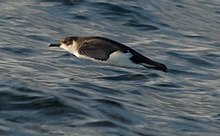The Barolo shearwater (Puffinus baroli), also known as the North Atlantic little shearwater or Macaronesian shearwater, is a small shearwater which breeds in the Azores and Canaries of Macaronesia in the North Atlantic Ocean. The English name and the specific baroli refers to Carlo Tencredi Falletti, marquis of Barolo.
| Barolo shearwater | |
|---|---|

| |
| Scientific classification | |
| Domain: | Eukaryota |
| Kingdom: | Animalia |
| Phylum: | Chordata |
| Class: | Aves |
| Order: | Procellariiformes |
| Family: | Procellariidae |
| Genus: | Puffinus |
| Species: | P. baroli
|
| Binomial name | |
| Puffinus baroli (Bonaparte, 1857)
| |
Taxonomy
editBarolo shearwater was formally described in 1857 by the French naturalist Charles Lucien Bonaparte under the binomial name Procellaria baroli.[1] The specific epithet commemorates Carlo Tencredi Falletti, marquis of Barolo.[2] This shearwater is now placed in the genus Puffinus that was introduced by the French zoologist Mathurin Jacques Brisson in 1760 with the Manx shearwater (Puffinus puffinus) as the type species.[3][4] The species in monotypic: no subspecies are recognised.[4]
It was previously considered conspecific with the little shearwater (Puffinus assimilis) of the southern hemisphere. Mitochondrial DNA cytochrome b sequence analysis indicated that baroli and boydi were very close to the nominate subspecies of Audubon's shearwater.[5] BirdLife International retain the forms baroli and boydi within little shearwater. The British Ornithologists' Union accepted P. baroli as a distinct species in 2005,[6] as has Clements Checklist. The American Ornithologists' Union followed in 2013.[7]
Description
editFeatures that distinguish the Barolo shearwater from the Manx shearwater and other North Atlantic Puffinus species include the pale face, silvery panel in the upperwings, shorter more rounded wings, and blue feet.[8] As well as the pale face with the darkly contrasting eye.[9]
Distribution
editThe Barolo shearwater breeds on the Azores, Desertas, Savage and Canary Islands.[10] The largest colony, of 1400 pairs, occurs on the Selvagen Islands.[11] The non-breeding range is the tropical and sub-tropic northeast Atlantic.[12]
Behaviour
editThe Barolo shearwater feeds in the upper 15m of the water column, which is similar to the closely related Audubon's shearwater Puffinus lherminieri of the western Atlantic and Caribbean Sea. Barolo shearwaters do not have a preferred time of day to forage or rest and they may hunt for food during either day or night, although they seem to be more ready to fly in the daylight hours. They feed mainly on fish and cephalopods, with Argonauta argo being the most common cephalopod taken in the Azores but also being part of a diverse selection of cephalopod prey, while the fish taken were almost exclusively Phycis spp.[13]
Threats
editLike other Procellariforms, introduced predators (rats and cats) must be their main threats at breeding colonies. In addition, fledglings are attracted to artificial lights at night during their maiden flights from nests to the sea.[14] On Tenerife, Canary Islands, a decline on the number of birds attracted to lights have been reported, suggesting a population decline on the island.[15]
References
edit- ^ Bonaparte, Charles Lucien (1857). Conspectus Generum Avium (in Latin). Vol. 2. Lugduni Batavorum: Apud E.J. Brill. p. 204.
- ^ Jobling, James A. (2010). The Helm Dictionary of Scientific Bird Names. London: Christopher Helm. p. 67. ISBN 978-1-4081-2501-4.
- ^ Brisson, Mathurin Jacques (1760). Ornithologie, ou, Méthode Contenant la Division des Oiseaux en Ordres, Sections, Genres, Especes & leurs Variétés (in French and Latin). Paris: Jean-Baptiste Bauche. Vol. 1, p. 56, Vol. 6, pp. 129-130.
- ^ a b Gill, Frank; Donsker, David; Rasmussen, Pamela, eds. (January 2022). "Petrels, albatrosses". IOC World Bird List Version 12.1. International Ornithologists' Union. Retrieved 19 February 2022.
- ^ Austin, J.J.; Bretagnolle, V.; Pasquet, E. (2004). "A global molecular phylogeny of the small Puffinus shearwaters and implications for systematics of the little-Audubon's shearwater complex". The Auk. 121 (3): 847–864. doi:10.1642/0004-8038(2004)121[0847:AGMPOT]2.0.CO;2. JSTOR 4090321.
- ^ Sangster, G.; Collinson, J.M.; Helbig, A.J.; Knox, A.G.; Parkin, D.T. (2005). "Taxonomic recommendations for British birds: third report". Ibis. 147 (4): 821–826. doi:10.1111/j.1474-919X.2005.00483.x.
- ^ Chesser, R.T.; Banks, R.C.; Barker, F.K.; Cicero, C.; Dunn, J.L.; Kratter, A.W.; Lovette, I.J.; Rasmussen, P.C.; Remsen, J.V.J.; Rising, J.D.; Stotz, D.F.; Winker, K. (2013). "Fifty-Fourth supplement to the American Ornithologists' Union Check-list of North American Birds". The Auk. 130 (3): 558–571. doi:10.1525/auk.2013.130.3.1.
- ^ McGeehan & Mullarney 1995, Martin & Rowlands 2001.
- ^ "Barolo's Shearwater Puffinus baroli (Bonaparte, 1857)". Wind Birds, Lda. 2005-10-07. Retrieved 10 December 2016.
- ^ Kirwan, G.M.; Carboneras, C.; Jutglar, F. (2020). Billerman, S.M.; Keeney, B.K.; Rodewald, P.G.; Schulenberg, T.S. (eds.). "Barolo Shearwater (Puffinus baroli), version 1.0". Birds of the World. Ithaca, NY, USA: Cornell Lab of Ornithology. doi:10.2173/bow.litshe1.01. S2CID 241706768. Retrieved 19 February 2022.
- ^ "Macaronesian Shearwater (Barolo Shearwater)". www.birdsandcompany.com. Retrieved 10 December 2016.
- ^ Ramos, R.; Paiva, V.H.; Zajková, Z.; Precheur, C.; Fagundes, A.I.; Jodice, P.G.R.; Mackin, W.; Zino, F.; Bretagnolle, V.; González-Solís, J. (2021). "Spatial ecology of closely related taxa: the case of the little shearwater complex in the North Atlantic Ocean". Zoological Journal of the Linnean Society. 191 (2): 482–502. doi:10.1093/zoolinnean/zlaa045. hdl:10261/228870.
- ^ Neves, V.C.; Bried, J.; González-Solís, J.; Roscales, J.L.; Clarke, M.R. (2012). "Feeding ecology and movements of the Barolo shearwater Puffinus baroli baroli in the Azores, NE Atlantic". Marine Ecology Progress Series. 452: 269–285. Bibcode:2012MEPS..452..269N. doi:10.3354/meps09670. hdl:2445/61235.
- ^ Rodríguez, Airam (2009). "Attraction of petrels to artificial lights in the Canary Islands: effects of the moon phase and age class". Ibis. 151 (2): 299–310. doi:10.1111/j.1474-919X.2009.00925.x. hdl:10261/45133.
- ^ Rodríguez, Airam (2012). "Trends in numbers of petrels attracted to artificial lights suggest population declines in Tenerife, Canary Islands". Ibis. 154: 167–172. doi:10.1111/j.1474-919X.2011.01175.x. hdl:10261/45113.